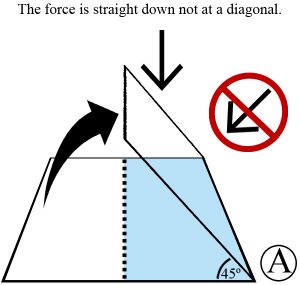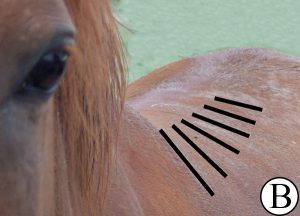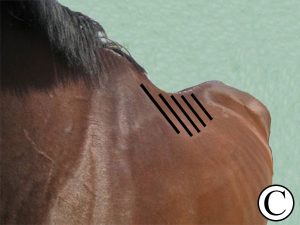There are always certain rider/horse combinations that present unique challenges for fitting a saddle to a horse. A situation came up a few weeks ago with a very narrow horse and a heavyweight rider. What I consider a heavyweight rider comes from the American Endurance Ride Conference. The AERC heavyweight division is 211 pounds and up. This weight includes tack. So taking away about 30 pounds for saddle, bridle etc. if you weigh 180 or more you would be in the heavyweight division.
The bottom line for saddle fit when it comes to having a happy horse is pounds per square inch. In our business over the years I came to believe that to keep an endurance horse happy for 100 miles you had to get the pressure down to 1.5 PSI or lower. As far as I know there has only been one clinical study done on this and it was published in Equine Veterinary Journal Supplement in November of 2010.
They found that the average pressure under a well fit saddle was always under 2 PSI, (usually well under 2 PSI). But even 2 1/4 to just over 3 PSI was causing muscle soreness under dry spots and 3 1/2 PSI and above caused obvious sores.
Calculating PSI is fairly straight forward. You just divide the rider’s weight by the square inches available on the bottom of the bars of the tree. So if you have a 225 pound rider on a tree with 150 square inches of bar surface you end up with 1.5 PSI. Awesome, no problem right? Well actually this isn’t the whole picture.
 The problem is we are not dealing with a flat surface parallel to the ground. (See A) When you take your surface and tip it up at an angle the effective surface area changes. At a 45 degree angle you lose about half of your surface area. (This is a simplification of the actually math involved because we are not considering the movement of the horse and also shear effects but I don’t want to turn this into a physics lecture.)
The problem is we are not dealing with a flat surface parallel to the ground. (See A) When you take your surface and tip it up at an angle the effective surface area changes. At a 45 degree angle you lose about half of your surface area. (This is a simplification of the actually math involved because we are not considering the movement of the horse and also shear effects but I don’t want to turn this into a physics lecture.)
 In most cases this doesn’t present a big problem because the shape of a horse’s rib cage flattens out and becomes wider as it goes back. (See B) So there is usually enough overall surface area to still come in under that 2 PSI safety zone. The challenge comes when you have a back that starts really narrow and stays narrow.
In most cases this doesn’t present a big problem because the shape of a horse’s rib cage flattens out and becomes wider as it goes back. (See B) So there is usually enough overall surface area to still come in under that 2 PSI safety zone. The challenge comes when you have a back that starts really narrow and stays narrow.
 So on that narrow horse’s back (See C) when you take that 225 pound rider and 150 square inches of bar surface and consider the 45 degree angle all the way back you can easily end up over 3 PSI. This is well over the safety zone.
So on that narrow horse’s back (See C) when you take that 225 pound rider and 150 square inches of bar surface and consider the 45 degree angle all the way back you can easily end up over 3 PSI. This is well over the safety zone.
As a saddle maker it’s my job to use every available square inch of the bars of the tree to get the pressure down to the lowest possible level. Whether or not we end up with a happy horse or not remains to be seen. If you’re only riding once or twice a week for an hour or so and mostly walking, there might not ever be a problem. However if you’re a hard core trail or endurance rider who is riding hundreds of miles a month you are way more likely to run into trouble.
So this leads us to a heavyweight rider will have far more success with a wider backed horse. But we run into a ‘Goldilocks and the Three Bears’ scenario here because heavyweight riders have trouble mounting a lot of times because the saddle slips to the side when they step into the stirrup.
Last month I wrote an article on the Combination Back. This is a horse that has a back that starts really narrow but gets wide very quickly. While some would think the combination back is a bad thing because they are harder to fit it’s actually the perfect type for a heavyweight rider. You get the side to side stability of a higher withered horse and the weight dispersion of a wider flatter back.
A narrow horse with a heavyweight rider is one of the most challenging scenarios we see. And the truth is it will work out fine for some and for others it’s just not. I was taught at a very young age to maximize your chance for success in anything, you need to get the right tool for the job. If you are a heavyweight rider on a narrow horse who likes to boogie down the trail with your hair on fire and you’re horse is continually coming up with a sore back you have to start thinking about getting a horse that is built for heavier riders.
Here is a link to the study I referred to:
http://onlinelibrary.wiley.com/doi/10.1111/j.2042-3306.2010.00191.x/full


Comments 2
Your article is “spot on!” For most of my adult life I was between 220 & 260# , raised & rode horses–was an avid trail rider.
Over the years, I tried and lost likely 500# but always gained back whatever I lost with interest.Thanks to having a gastric bypass in 2002, I now fluctuate between 130 & 135#. My horses & I are MUCH happier!!!!!!!!!!!!!!
It is critical if you care about our beasts of burden to factor in their safe for them carrying capacity.
P.S. I will be 75 next month and remain an avid trail rider and a member of Back Country Horsemen
I’m heavy. So when I bought my horse, I made sure she would be able to carry me if we went for a 4 hr. ride. She has, with ease. She is a wonderful Quarter/Halflinger mix. The only bad thing about her is she is very hard to fit. Everything from halters, bits, girths to saddles themselves takes multiple tries. She has a heart of gold, so worth the effort.